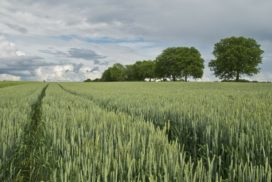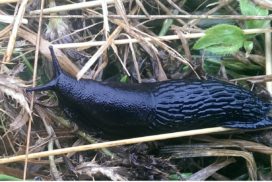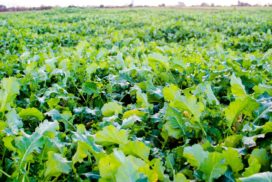Crop Health Updates - August 2020
General Comments
There is a sense of déjà vu from last year, with the weather affecting the cereal harvest again, although many are trying to get crops in when they can. The clash of wheat and spring barley harvest in some areas will cause some headaches, but what we need is a dry spell of weather to allow field work to be maximized and get the harvest done. Yields of the winter crops tend to be average or below average, but there is hope that the spring cereals may be better. It has been pointed out that grain stores may be fuller than usual this season, alas not from higher yields but due to them not being emptied from last years grain. This may create a few issues, particularly with growers who usually bring in the grain to an empty store. The grain driers will need to be working overtime as well, increasing costs. Planting of next years crops is underway in many areas, with oilseed rape emerging quickly, and in a race to outrun slugs in some cases. Bets are off as to who may win that race.
Potato crops are looking good in most areas, with many seed crops and salads ready to lift imminently. There have been issues with regrowth which in seed crops poses a risk of virus infection by aphids.
The weather is keeping pest activity down to some extent, although we are still seeing egg laying by cabbage root fly, carrot fly and moths in brassicas and carrots.
Harvested Crops - August 2020
Ensuring stores are clean and free of pests is essential to prevent any problems after all the hard work of growing and harvesting the crop.
Read more here
All Cereal Weed Management - August 2020
Pre-harvest and desiccation options for cereals
Due to the difficult growing season, there are crops with secondary tillers and uncontrolled weeds that will benefit from pre-harvest glyphosate. Read more here
Winter Barley Update - August 2020
Harvest is now well underway in most areas, with rainfall hindering progress. There are some concerns over sooty moulds and quality issues where crops linger, read more here
Winter Barley Variety Choices for Autumn 2020
North region yields are given as the % of fungicide-treated controls (9.9 t/ha). Untreated yield is a % of UK treated controls (10.0 t/ha). In two-row feed varieties, the best yields have been achieved by LG Mountain, KWS Creswell, KWS Hawking and LG Flynn. Feed varieties with the best grain quality are Valerie, KWS Cassia and LG Flynn. Most two-row varieties have weakness to one or more of the major diseases e.g. mildew, Rhynchosporium or net blotch.
Read more here
Winter Wheat Variety Choices for Autumn 2020
Winter wheat varieties with soft endosperm remain the most important choices for Scottish growers in meeting the needs of the grain distilling sector. The leading soft Group 4 varieties for distilling are Elation, KWS Jackal, and LG Skyscraper. Click here for more information
Spring Barley Update - August 2020
There seem to be quite a few cases of blind and empty ears of spring barley in crops which relate to the early stressful weather conditions in the spring/summer and the wet weather over flowering. Read more here
Winter Oilseed Rape Update - August 2020
Pests
During the oilseed rape harvest keep an eye on the sides of the trailers. The presence of any blue-black beetles in harvested oilseed rape seed or seen on the trailers is a warning.
Weeds
There are now more options for varying approaches to weed control in oilseed rape. For fields that have cruciferous weeds or volunteer oilseed rape, Clearfield varieties are a good choice.
Read more here
Potatoes Update - August 2020
Potato blight
Blight risk
Check the AHDB Potatoes Fight against Blight website regularly for the most up-to-date information on the appearance of confirmed blight outbreaks. Up to 29 July there are two outbreaks in Scotland confirmed both in the IV12 postcode. In addition, blight has recently been confirmed on groundkeepers in South Ayrshire (KA6).
Also, check BlightWatch or BlightCAST for the general blight-weather risk where your crops are located. In the last 7 days many areas in Scotland have had between 1 and 3 Hutton Periods. Read more here
Spring Peas and Beans Update - August 2020
Pre-harvest desiccation options
Combine peas
Due to the indeterminate nature of combining peas, most combining pea crops in Scotland benefit from desiccation, unless it is an exceptionally dry harvest. Read more here
Pre-Harvest and Desiccation Option Update - Mid August 2020
If using a pre-harvest spray with glyphosate in cereals, remember to adhere to the recommended timing – not to treat before crop grain moisture has fallen below 30%.
Treating earlier than this increases the likelihood of residues in the grain. In weedy crops or those with secondary growth as seen this year, there is a proven benefit from pre-harvest glyphosate, particularly if the weather turns wetter. For clean cereal crops there is generally no proven benefit, although trials have shown a small benefit in spring barley. Check with the end user and do not treat seed crops.
Read more here
Winter Oilseed Rape Update - Mid August 2020
The key pests to consider in winter oilseed rape in the autumn are flea beetle, cabbage stem flea beetle, peach-potato aphid (and turnip yellows virus - TuYV) and later in the autumn rape winter stem weevil. Slugs are also a perennial problem, and reliance on fine seed beds and slug pellets (metaldehyde and ferric phosphate) remains for this pest, with careful use of metaldehyde a necessity to avoid contamination of water.
Read more here
Potatoes Update - Mid August 2020
Pests
The weather has been favouring slugs this season and it is worth doing some test digs to see if there is any sign of slug or wireworm damage to tubers. Wireworm damage tends to be small holes penetrating the tuber whereas slug damage tends to be more irregular shaped holes. Unfortunately nothing can be done for wireworm apart from lifting the crop as soon as it is practical to do so, as damage will only get worse the longer the crop is in the ground. Read more here
Vegetable and Forage Brassicas Update - Mid August 2020
Pests
We have seen an increase in cabbage root fly egg laying and egg hatch over the last week at our monitored crops. Cyantraniliprole can still be applied as a drench treatment to crops in the field such as brussels sprout, cabbage, cauliflower, broccoli, turnip and swede but time for effective control is running out. Read more here
Carrots and Parsnips Update - Mid August 2020
Pests
The second generation of adult carrot fly are now being seen in our monitored crops. Crops that were sown with seed treated with tefluthrin will be not be protected from larvae arising from this second generation of carrot fly.
Foliar insecticide sprays will be needed to target the adult flies before they lay their eggs.
Bracken Update - Mid August 2020
The Bracken Control Group has noted that in many areas of the UK bracken is starting to senesce earlier than usual this year.
It’s something to watch out for, as Asulox is translocated less in crops that have started to die back. For more information click here
Haulm Destruction without Diquat
With many seed potato crops around Scotland coming up to size rapidly, potato growers are getting to grips with haulm destruction in the post-diquat era.
The good news is that there are still viable options to bring down even vigorous canopies, but a change of mindset is needed.
Read more here
Aphids and Barley Yellow Dwarf Virus on Autumn Sown Cereals
Barley yellow dwarf virus (BYDV) has been seen in several winter and spring cereals this season
Aphids can be seen on crops and volunteers. There is a risk of cereal aphids picking up BYDV from infected plants and spreading the virus to cereals as they emerge this autumn. Read more here
Cabbage Stem Flea Beetle and Oilseed Rape
Cabbage stem flea beetle has been wreaking havoc on English winter oilseed rape crops for several years now due to the loss of the neonicotinoid seed treatments and resistance to pyrethroid insecticides.
We don’t know the detailed status of pyrethroid insecticide resistance in Scottish cabbage stem flea beetles, but there is likely to be some level of resistance here. Click here to read more
All Winter Crops - Late August 2020
Forward planning - Slugs
With slugs being very visible in crops and stubble, there is an increased risk of slug damage to winter oilseed rape and winter cereals this season. Slug trapping can be used to assess the risk from slugs in a particular field. To get the best and most accurate results from slug trapping the bait placed under the trap needs to grab the slugs’ interest and to keep them there. Read more here
All Winter Cereals - Late August 2020
BYDV – forward planning
Barley yellow dwarf virus (BYDV) has been seen in several winter and spring cereals this season. Aphids can be found on crops and volunteers although the rain may well have washed a few off. There is a risk of cereal aphids picking up BYDV from infected plants and spreading the virus to cereals being sown this autumn. Read more here
Winter Wheat - Late August 2020
Pests
Wheat bulb flies will be laying eggs through to late September. Growers are advised to identify potential fields at risk now and consider an assessment of egg numbers from early-September in fields planned for wheat. See more here
Winter Oats - Late August 2020
Weeds
Herbicide options for winter oats are limited, particularly for grass weeds. However, this is to some extent compensated by the competitiveness of oats and the ability to supress weeds. Due to the lack of herbicides, minimal cultivation practices in winter oats are risky where there is a grass weed problem such as bromes. There is no herbicide option for control of rye-grasses or wild oats in winter oats. Limited control of black-grass is possible. Read more here
Winter Oilseed Rape - late August 2020
Most crops are now harvested. Yields to date seem reasonable and some of the new season crop is already drilled. Phoma risk is still low in our region and decisions around light leaf spot fungicides are some way off yet. Read more here
Potatoes - Late August 2020
The first season without diquat is throwing up a couple of issues.
Many crops have come up to size quickly and were flailed early. We have seen copious regrowth after flailing for some seed crops of indeterminate varieties. Our advice remains to monitor flailed crops for regrowth, and if necessary, apply a desiccant. Click here to read more
Vegetable and Forage Brassicas - Late August 2020
Pests
Cabbage root fly egg laying is still underway but has dropped off as the tail end of the 2nd generation drags out due to the wet weather. Click here to read more
Carrots and Parsnips - Late August 2020
Pests
The second generation of adult carrot fly are still being seen in our monitored crops. Crops that were sown with seed treated with tefluthrin will be not be protected from larvae arising from this second generation of carrot fly. Read more here
Crop Residue - Late August 2020
SRUC is working with partners across Europe to improve the estimation of how management of crop residues can contribute to reducing agricultural greenhouse gases emissions and enhance soil carbon storage. Click here to read more
Sign up to the FAS newsletter
Receive updates on news, events and publications from Scotland’s Farm Advisory Service

























